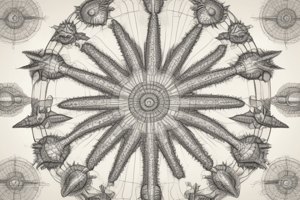Podcast
Questions and Answers
What type of symmetry is generally observed in echinoderms?
What type of symmetry is generally observed in echinoderms?
- Bilateral symmetry
- Radial symmetry (correct)
- Asymmetrical
- None of the above
How do holothurians primarily obtain their food?
How do holothurians primarily obtain their food?
- By photosynthesis
- As filter feeders
- As detritivores (correct)
- By hunting small fish
Which characteristic is NOT shared by all animals?
Which characteristic is NOT shared by all animals?
- Capability for asexual reproduction (correct)
- Complex structures like tissues and organs
- Respiratory organs adapted to their environment
- Ability to reproduce sexually
What type of reproductive process can some echinoderms undergo?
What type of reproductive process can some echinoderms undergo?
What is the primary function of the ambulacral system in echinoderms?
What is the primary function of the ambulacral system in echinoderms?
Flashcards
Sexual reproduction
Sexual reproduction
The ability of an organism to produce offspring through the fusion of gametes (sperm and egg). Both processes are crucial for maintaining genetic diversity in animal populations and ensuring the continuation of the species.
Detritivores
Detritivores
Organisms that obtain nutrients by consuming dead organic matter. They are essential for decomposing organic materials and recycling nutrients within ecosystems.
Ambulacral system
Ambulacral system
A fluid-filled network of tubes in echinoderms that enables movement. The system acts like a hydraulic system, using water pressure to extend and retract tube feet, allowing for locomotion.
Asexual reproduction
Asexual reproduction
Signup and view all the flashcards
Dermoskeleton
Dermoskeleton
Signup and view all the flashcards
Study Notes
Animal Characteristics
- Animals exhibit limited growth.
- Most animals move from place to place.
- Many animals display bilateral symmetry, some radial symmetry, and a few are asymmetrical.
- Animals have a high level of interaction.
- Animals form complex structures like tissues and organs.
Animal Respiratory and Reproductive Characteristics
- Animals have respiratory organs adapted to their environment.
- Animals primarily reproduce sexually, but some invertebrates can reproduce asexually.
- Animal reproduction may involve external or internal fertilization.
- Animal development can be direct or indirect (metamorphosis).
Echinoderms (Phylum Echinodermata)
- Echinoderms are aquatic invertebrates found in the sea.
- Echinoderms generally exhibit radial symmetry.
- Echinoderms have a dermoskeleton, a rigid structure beneath their skin.
- Echinoderms utilize an ambulacral system for movement, which is a network of water-filled tubes.
- Echinoderms have a complete digestive system.
- Echinoderms commonly reproduce sexually, and some can reproduce asexually through fragmentation.
Holothurians (Class Holothuroidea)
- Holothurians, also known as sea cucumbers, possess elongated bodies without arms or spines.
- Holothurians are detritivores (feed on decaying organic matter).
Studying That Suits You
Use AI to generate personalized quizzes and flashcards to suit your learning preferences.
Description
This quiz covers key characteristics of animals, focusing on their growth, movement, symmetry, and respiratory and reproductive traits. Additionally, it delves into the specific features of echinoderms, their structure, and unique systems. Test your knowledge on these fascinating biological concepts!




